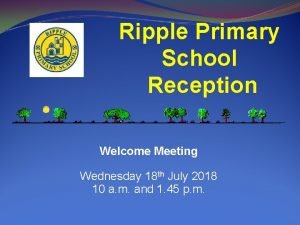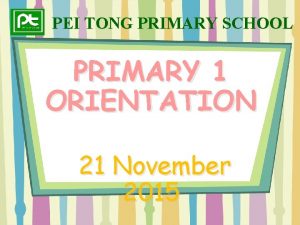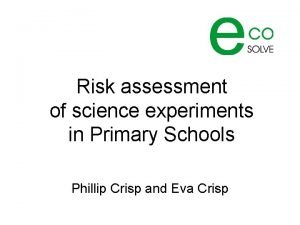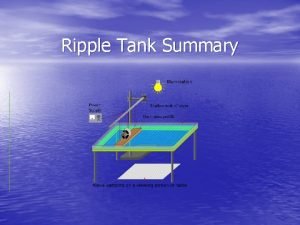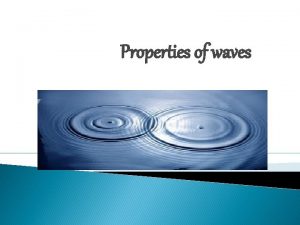Ripple Primary School PSQM Principles of Good Science








- Slides: 8

Ripple Primary School PSQM Principles of Good Science Teaching

Summary of content • Ripple have developed the Principles of Science in their school through whole staff consultation and agreement, a method that gives ownership to all thus ensuring it is embedded in practice. • This is a good way of making significant impact on the provision of Science enquiry, as seen here in the examples of planning and child led enquiry. • The principles of Sc 1 skills can clearly be seen in the examples of children’s work.

What the schools say v Creating this document was a great way to get the whole school teaching team to meet together to discuss and agree on what good science is. This raised awareness of the subject throughout the school, acknowledged much good practise that was already in place and steered us in the right direction to make improvements which had been agreed by all. v We met as a staff to discuss and agree the principles of good science teaching. All teaching staff had the opportunity to contribute so there is a feeling of ownership. v Working on the principles together raised the profile of science. Children’s enjoyment and the importance of practical science investigations was highlighted. Science AT 1 skills development across the school was a clearer focus as a result. I was able to use the document when monitoring books, displays and on learning walks. v We will continue to use the document for monitoring purposes. Year groups are now taking more ownership of monitoring books and can use this document to support that. We plan to review the document in Autumn 2012 with the whole staff.

At Ripple Primary School we know good science occurs in our school when… • • • Children’s attitude to science is positive Children are interested and excited Children are learning Children are asking questions Children are able to talk confidently about their learning Children want to find out more about their science topics – – – – Whole investigations are happening There are interesting science displays Cross-curricular links are planned for and embedded Children make progress in the lessons There is positive feedback from staff Children develop their Sc 1 skills of • Observing • Exploring • Questioning • Using scientific vocabulary • Measuring • Modelling (Particularly in EYFS but applicable to all) Demonstrating understanding and following up new learning in their self chosen activities and therefore making connections between different aspects of their learning. Agreed Autumn 2010. To be reviewed Autumn 2012

Ask questions and encounter challenging problems and independently come up with ways to investigate them using growing scientific skills Child A - RVW Exploring – a strong feature of EYFS curriculum that we have incorporated into good science practice Observing Questioning Carefully framed open ended question Making connections Children encouraged to reflect on their work

ANNOTATED PLANS: SPRING TERM VOCABULARY Soundproof, change, measure, observe, fair test, prediction, factor Week WEEKLY PLANNING SHEET 6 SCIENCE - SOUND (5 F) WEEK BEGINNING: 7/2/11 LEARNING OBJECTIVES (WHAT CHILDREN SHOULD KNOW AND UNDERTSAND) To plan a fair test, obtain evidence and consider results That some materials reduce the amount of sound that reaches the ear Aim: to investigate materials used for soundproofing ICT used selectively to support learning Children raising their own questions Application of science skills – designed so children can approach task at their own level TEACHING STRATEGIES AND CHILDREN’S ACTIVITIES INTRODUCTION Discuss with children why it is sometimes important to prevent sounds travelling. Can annoy other people, can damage our ears, can prevent us hearing something important like oncoming cars when we are crossing the road, etc. Ask them to suggest how this can be done, e. g. ear muffs, ear plugs, soft floor coverings, etc. Look at (Section 1) http: //www. ngflcymru. org. uk/vtc/16022007/sound_travels/lesson. html. Show and discuss soundproofing example sheet. EXPOSITION & GUIDED PRACTISE Tell the children that during this lesson they are going to try and help solve a small problem. Explain that Martin (our nature garden designer) is going to be using some noisy machinery over the next couple of weeks and needs to use the best sound protectors for his ears. We need to help solve this for him. As a class raise a question for investigation e. g. Which is the best material to muffle sound? OUTCOMES/ WORK TO BE PRODUCED LENGTH AND QUALITIES Children can: Make predictions based on observations and prior knowledge about the effectiveness of materials for soundproofing Contribute to planning a fair test State that some materials are more effective at soundproofing than others Describe ways in which they think their work could have been improved RESOURCES Concept cartoon Soundproofing example sheet Investigation worksheet Paper cups Range of materials e. g. bubble wrap, cotton wool, material etc Practical science Task In groups children conduct investigation. Use Investigation sheets throughout. Evaluate, draw conclusions and discuss. PLENARY Using their results, the children could design the sound protectors they would recommend Martin use! AFL Open ended investigation given real life context Assessment statement: Suggest how to investigate how well sound travels through materials and say how good their evidence is. Children working independently on challenging problem – all groups had different solutions AFL

Y 5 Forces/Weight lesson observation Judgement = GOOD Modelling AFL Exploring and observing Dialogic teaching AFL Using ICT to support learning Using scientific vocabulary

We also drew around Shanice’s shadow every hour. Slide from Y 6 work on shadows – shows use of outdoor classroom for practical science work Measuring Whole investigations are happening Exploring and observing How did her shadow change through the day?
